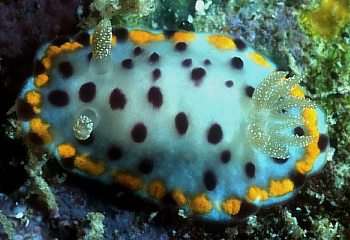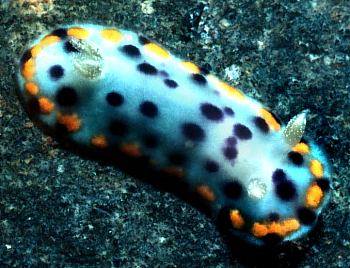

Chromodoris kitae
Gosliner, 1994
Order: NUDIBRANCHIA
Suborder: DORIDINA
Superfamily: EUDORIDOIDEA
Family: Chromodorididae
DISTRIBUTION
Known from Madagascar and South Africa
PHOTO
Madagascar. Photo: Terry Gosliner
Very similar in colour to Chromodoris tumulifera. Main point of difference would seem to be the white spots on the gills and rhinophores in C. kitae. See messages below and on C. tumulifera Page for further discussion.
Reference:
• Gosliner, T.M. (1994) New species of Chromodoris and Noumea (Nudibranchia: Chromodorididae) from the western Indian Ocean and southern Africa. Proceedings of the California Academy of Sciences 48(12): 239-252. (8 figs)
Rudman, W.B., 2002 (February 13) Chromodoris kitae Gosliner, 1994. [In] Sea Slug Forum. Australian Museum, Sydney. Available from http://www.seaslugforum.net/find/chrokita
Related messages
Chromodoris kitae from Madagascar
February 15, 2002
From: Terry Gosliner


Dear Bill,
I was looking at the photo that Valda sent that you said looks very much like C. kitae and noted your comment that you thought C. kitae fell within the variation of C. tumulifera. You did not mention one of the key differences we found consistently in C. kitae, from Madagascar. The rhinophores and gill of C. kitae always have a series of opaque white spots on the rhinophores that seem to be absent in all the illustrated specimens of C. tumulifera or C. bimaensis from the western Pacific. Unfortunately the photo that Valda sent is a bit dark and I can't make out enough detail on the gills and rhinophores. My sense is that C. kitae represents a distinct species. I am sending you two scans of specimens of C. kitae fom Madagascar.
Cheers,
Terry
tgosline@CalAcademy.org
Gosliner, T. , 2002 (Feb 15) Chromodoris kitae from Madagascar. [Message in] Sea Slug Forum. Australian Museum, Sydney. Available from http://www.seaslugforum.net/find/6243Dear Terry,
Thanks for the photos and for drawing my attention to the white spots. The presence or absence of white spots will certainly be something for people to keep an eye out for. I am sending as separate messages photos of an animal from New Caledonia which has a broken yellow border like typical C. kitae but doesn't have white spots on the gills and rhinophores, and a photo of an animal from Fiji that I initially identified as Chromodoris bimaensis in which some of the purple spots have become rings. With your photos, I think the Forum now has photos of all the various colour variations of this C. tumulifera - bimaensis - kitae group.
I realise Valda's photo is a bit underexposed, but it seems to have a continuous, rather than broken orange band, and seems to lack the white spots on the gills and rhinophores. It will certainly be interesting to see what colour variation can be found in the Indian Ocean.
Best wishes,
Bill Rudman
Chromodoris tumulifera from SA
February 13, 2002
From: Valda Fraser

Dear Bill,
My friend Dennis King took this photo and unfortunately it's a very sad one - wrong setting on the camera. A problem we have all experienced! Can you help with identification? I'm at a loss.
Location: Durban, South Africa, 25m
Size: 20mm
Date: January 2002
Thanks.
Valda Fraser
valdafraser@mweb.co.za
Fraser, V., 2002 (Feb 13) Chromodoris tumulifera from SA. [Message in] Sea Slug Forum. Australian Museum, Sydney. Available from http://www.seaslugforum.net/find/6200Dear Valda,
I am pretty sure this is Chromodoris tumulifera. It fits the colour pattern of Chromodoris kitae from Madagascar, but as I comment elsewhere, the colour differences are so slight that I think C. kitae falls within the colour range of C. tumulifera.
Best wishes,
Bill Rudman
